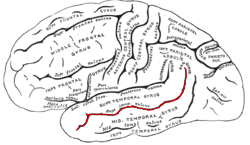| Superior temporal sulcus | |
|---|---|
 | |
 | |
| Details | |
| Part of | Temporal lobe |
| Identifiers | |
| Latin | sulcus temporalis superior |
| NeuroNames | 129 |
| TA98 | A14.1.09.145 |
| TA2 | 5494 |
| FMA | 83783 |
| Anatomical terms of neuroanatomy | |
In the human brain, the superior temporal sulcus (STS) is the sulcus separating the superior temporal gyrus from the middle temporal gyrus in the temporal lobe of the brain. A sulcus (plural sulci) is a deep groove that curves into the largest part of the brain, the cerebrum, and a gyrus (plural gyri) is a ridge that curves outward of the cerebrum.[1]
The STS is located under the lateral fissure, which is the fissure that separates the temporal lobe, parietal lobe, and frontal lobe.[1] The STS has an asymmetric structure between the left and right hemisphere, with the STS being longer in the left hemisphere, but deeper in the right hemisphere.[2] This asymmetrical structural organization between hemispheres has only been found to occur in the STS of the human brain.[2]
The STS has been shown to produce strong responses when subjects perceive stimuli in research areas that include theory of mind, biological motion, faces, voices, and language.[3][4]
- ^ a b Bui, Toai; M Das, Joe (2020), "Neuroanatomy, Cerebral Hemisphere", StatPearls [Internet], Treasure Island (FL): StatPearls Publishing, PMID 31747196, NBK549789
- ^ a b Leroy, F; et al. (27 January 2015). "New human-specific brain landmark: the depth asymmetry of superior temporal sulcus". Proceedings of the National Academy of Sciences of the United States of America. 112 (4): 1208–13. Bibcode:2015PNAS..112.1208L. doi:10.1073/pnas.1412389112. PMC 4313811. PMID 25583500.
- ^ Beauchamp, MS (September 2015). "The social mysteries of the superior temporal sulcus". Trends in Cognitive Sciences. 19 (9): 489–90. doi:10.1016/j.tics.2015.07.002. PMC 4556565. PMID 26208834.
- ^ Deen, B; Koldewyn, K; Kanwisher, N; Saxe, R (November 2015). "Functional Organization of Social Perception and Cognition in the Superior Temporal Sulcus". Cerebral Cortex. 25 (11): 4596–609. doi:10.1093/cercor/bhv111. PMC 4816802. PMID 26048954.